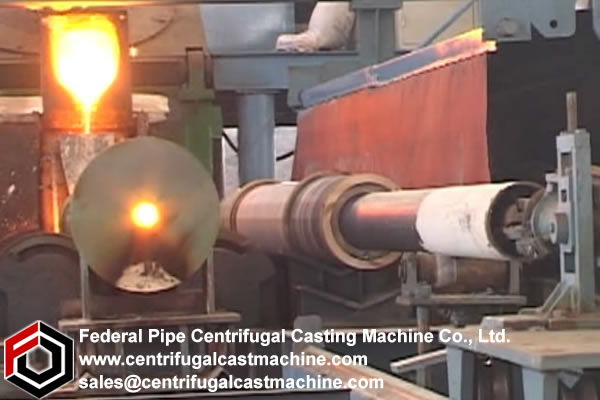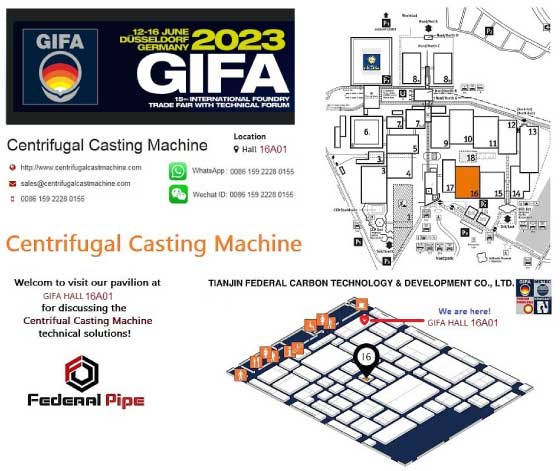Centrifugal casting method and apparatus Centrifugal Casting Machine
The process of centrifugal casting of metal objects, and in particular of iron pipe, is well known and has been practiced for nearly a century. A centrifugal casting machine includes a delivery system, such as a trough, and a rotating mold. Molten iron is poured from a machine ladle into the trough. The trough extends into the interior of the rotating mold, generally axially. One end of the mold usually includes a core, such as a sand core, to accurately shape what is called the bell of the pipe. The opposite end of the pipe is referred to as the spigot, and the elongated section in between is the barrel. The molten iron flows down the trough under the influence of gravity. The mold and trough are moved relative to one another to fill the mold with iron, typically from the bell end along the barrel to the spigot. As the mold rotates, centrifugal force disposes the iron circumferentially around the mold in a relatively even manner. Typically, the casting machine is moved via hydraulics or other mechanical means, as is known in the art, to dispose the iron as desired.
Variation in the charge mix (i.e., the source of raw material for the foundry, such as scrap iron), coke, and cupola operation results in variation in the molten iron temperature and chemical composition. This in turn causes variations in frictional forces, surface tension, heat diffusivity, and fluidity of the molten iron from which each pipe is cast, resulting in inconsistency in the flow rate of iron to the mold. Even with hydraulic systems controlled by programmable logic controllers (PLCs), uniformity of results and adherence to specifications can be difficult to achieve. For example, the wall thickness of the pipe may not be uniform from end to end. The casting operator cannot detect changes in the iron that affect wall thickness uniformity in a timely manner in order to adjust the casting machine controls. The variation in molten iron content cannot be cost effectively eliminated in a facility using material from recycled or scrap sources.
The variation in content of the molten iron manifests itself in the liquidus arrest temperature and the fluidity of the molten iron. The liquidus arrest temperature (LA) is the temperature at which a molten metal changes phase to a solid state. While the liquidus arrest temperature may be calculated if the precise chemical composition of the molten metal is known, that composition may not be known. This is true, for example, in foundries using scrap or other recycled sources of metal, which contain varying amounts of the key chemicals carbon, silicon, and phosphorous, as well as amounts of unknown materials that may affect the fluidity of the alloy.
The variations in the liquidus arrest temperature cause variations in the fluidity of molten metal at a given temperature. Fluidity is a technological characteristic of molten metal that indicates how well the molten metal flows into a mold. Fluidity is driven by metallostatic pressure and hindered by surface tension, heat diffusivity, and friction. The term fluidity, as used in the foundry industry and as used herein, is different than the usage by physicists, who use the term as the reciprocal of viscosity. Fluidity is quantified in terms of the distance (inches) a molten metal such as iron will flow through a standard fluidity spiral pattern until solidification blocks the flow.
http://www.centrifugalcastmachine.com/Iron-soil-pipe-centrifugal-casting-machine/95.html
